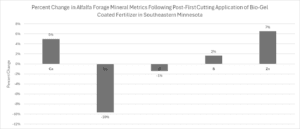Bio-Gel Boosts Alfalfa Yield and Quality in SE Minnesota Trial
Boosts Alfalfa Yield and Quality in SE Minnesota Trial
An on-farm trial conducted in Southeastern Minnesota evaluated the impact of Bio-Gel dry granular-coated fertilizer applied after the first cutting of alfalfa. The results demonstrated multiple agronomic and forage quality benefits that support both crop productivity and livestock nutrition. Results from Bio-Gel Dry Coated Fertilizer Trial in SE Minnesota. Coated a 185 pounds per acre of a 0-0-24 blend applied June 2nd. Samples were collected on June 30th.



One of the most notable improvements was a measurable increase in crude protein content, a key indicator of forage nutritional value. Higher crude protein levels enhance the dietary intake of ruminant animals, leading to improved weight gain, milk production, and overall herd performance. Alongside this, the total amino acid concentration also increased, further improving the protein quality by supplying essential building blocks for animal growth and health.
The trial also revealed increases in calcium, boron, and zinc concentrations in the alfalfa tissue. Calcium is critical for plant structural integrity and forage palatability, while boron supports cell wall development and reproductive growth. Zinc plays a key role in enzyme function and protein synthesis. These micronutrient gains not only reflect better plant health but also enhance the mineral content of the forage for livestock.
In contrast, the levels of sodium and chloride—two elements that can be detrimental in excess—were reduced. Lower sodium and chloride improve the forage’s palatability and minimize potential issues related to salt toxicity or imbalanced mineral intake in animals.
Furthermore, the Bio-Gel treatment resulted in an increase in both the digestible organic matter index (DOMI) and dry matter yield.
Agronomic & Livestock Benefits of Bio-Gel in Alfalfa: SE Minnesota Field Trial Insights
1. Increased Crude Protein for Better Forage Nutrition
- Boosts forage nutritional value.
- Supports improved milk production, weight gain, and animal performance.
- Reduces need for supplemental protein in feed rations.
2. Elevated Amino Acid Levels for Superior Feed Quality
- Enhances protein quality—not just quantity.
- Provides essential nutrients for muscle development and animal health.
3. Enhanced Micronutrient Uptake
- Higher Calcium: Strengthens plant structure and improves forage quality.
- Increased Boron & Zinc: Promotes plant growth, nutrient uptake, and overall plant vigor.
- Micronutrient-rich forage supports healthier, more productive livestock.
4. Reduced Sodium and Chloride for Improved Palatability
- Reduces salt stress on plants.
- Improves palatability and feed intake in livestock.
- Minimizes risk of mineral imbalance or toxicity.
5. Higher Forage Digestibility and Energy Availability
- Higher Digestible Organic Matter Index (DOMI): Increases energy availability from forage.
- Leads to more efficient feed conversion in livestock.
6. Increased Dry Matter Yield Per Acre
- More biomass per acre.
- Increases return on investment through higher harvestable forage.
7. Timely Application After First Cutting
- Applied after first cutting, targeting critical regrowth period.
- Supports consistent quality through subsequent cuttings.
8. Proven Results from SE Minnesota On-Farm Trial
- Real-world results under regional growing conditions in Southeastern Minnesota.
- Demonstrated agronomic and economic value.

